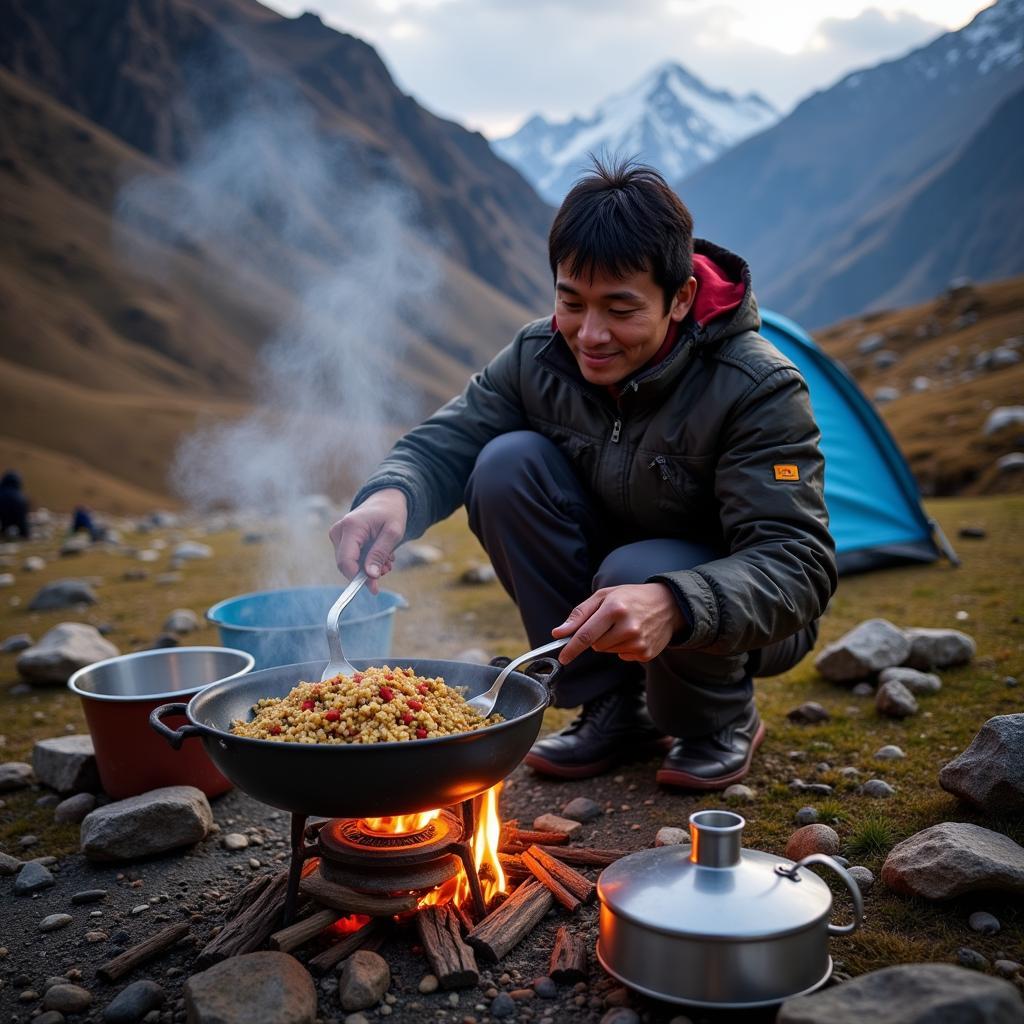Scaling the majestic Mount Everest is a feat that pushes human endurance to its limits. But what about fueling that endurance? What do people eat on Everest to power their grueling climb? The Food On Everest isn’t just about sustenance; it’s a crucial factor in success, providing the energy needed to battle extreme altitudes, freezing temperatures, and treacherous terrain.
A Climber’s Diet: More Than Just Trail Mix
Forget granola bars and energy gels – while convenient, the food on Everest needs to pack a serious caloric punch. We’re talking upwards of 7,000 calories a day! This high-energy intake combats the body’s accelerated calorie burn at high altitude, a consequence of the extreme conditions and physical exertion.
From Base Camp to the Death Zone: How the Menu Changes
The food on Everest isn’t static; it evolves alongside the climb itself. At Base Camp, where acclimatization is key, meals are surprisingly diverse. Think hearty soups, rice dishes, pasta, and even fresh vegetables. This abundance dwindles as climbers ascend, with the focus shifting towards lightweight, calorie-dense options like freeze-dried meals, nuts, and chocolate.
Above 8,000 meters, in the aptly named “Death Zone,” appetite often plummets due to the altitude’s effect on digestion. Here, easy-to-digest, high-calorie liquids like soup and hot chocolate become essential for survival.
“Imagine trying to eat a steak when all you want is a cup of broth,” shares experienced Everest guide, Pasang Dawa. “Appetite suppression is a real challenge up high, so we encourage climbers to focus on consuming calories in whatever form they can manage.”
Hydration is Key: Melting Snow and Sipping Electrolytes
While food provides calories, staying hydrated is equally critical on Everest. Climbers melt snow for drinking water and rely on electrolyte-rich beverages to replenish lost minerals through sweat and exertion. Dehydration can quickly lead to altitude sickness, a dangerous foe at such heights.
Local Cuisine With a High-Altitude Twist
The food on Everest often features local Nepali staples, albeit with a focus on energy density. Dal Bhat, a lentil soup with rice, is a popular choice, providing a balance of carbohydrates, protein, and fiber. Momos, Tibetan dumplings filled with meat or vegetables, offer a tasty and portable energy boost.
 Sherpa Preparing a Traditional Nepali Meal for Climbers
Sherpa Preparing a Traditional Nepali Meal for Climbers
A Glimpse into the Future: Evolving Food on Everest
As technology advances, so too does the food on Everest. Freeze-dried meals are becoming increasingly palatable, and some expeditions even experiment with pre-cooked meals that can be reheated at altitude. The goal? To provide climbers with nutritious, energy-dense food that helps them power their way to the top of the world.
FAQs About Food on Everest
Q: Can climbers bring their own food to Everest?
A: While climbers can bring some personal snacks, the majority of the food is provided by the expedition company and prepared by experienced Sherpa cooks.
Q: What happens to food waste on Everest?
A: Waste management is crucial on Everest. Climbers are required to pack out all their trash, including food waste, to minimize environmental impact.
Q: Are there any dietary restrictions accommodated on Everest expeditions?
A: Most expedition companies are able to accommodate dietary restrictions with advance notice. Be sure to communicate your needs clearly when booking your trip.
Need More Information?
For more insights into the fascinating world of food on Everest, explore our related articles:
Contact Us
Have questions or need assistance with your food and travel needs? Contact us at:
Phone: 02437655121
Email: [email protected]
Address: 3PGH+8R9, ĐT70A, thôn Trung, Bắc Từ Liêm, Hà Nội, Việt Nam.
Our customer service team is available 24/7 to assist you.